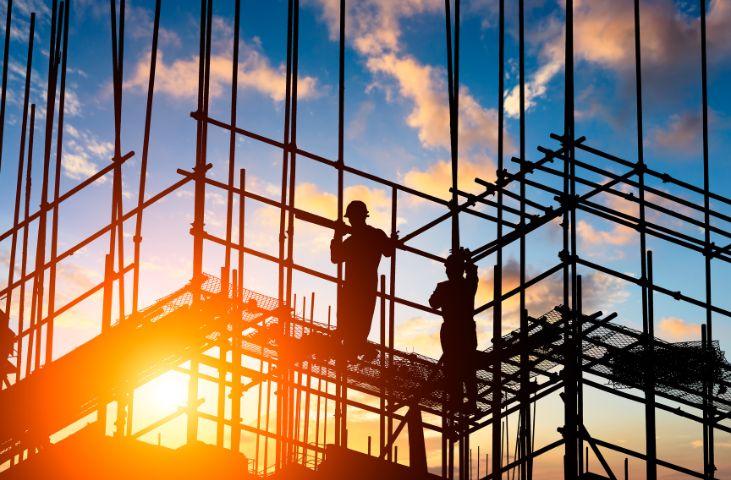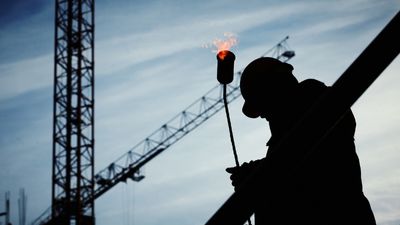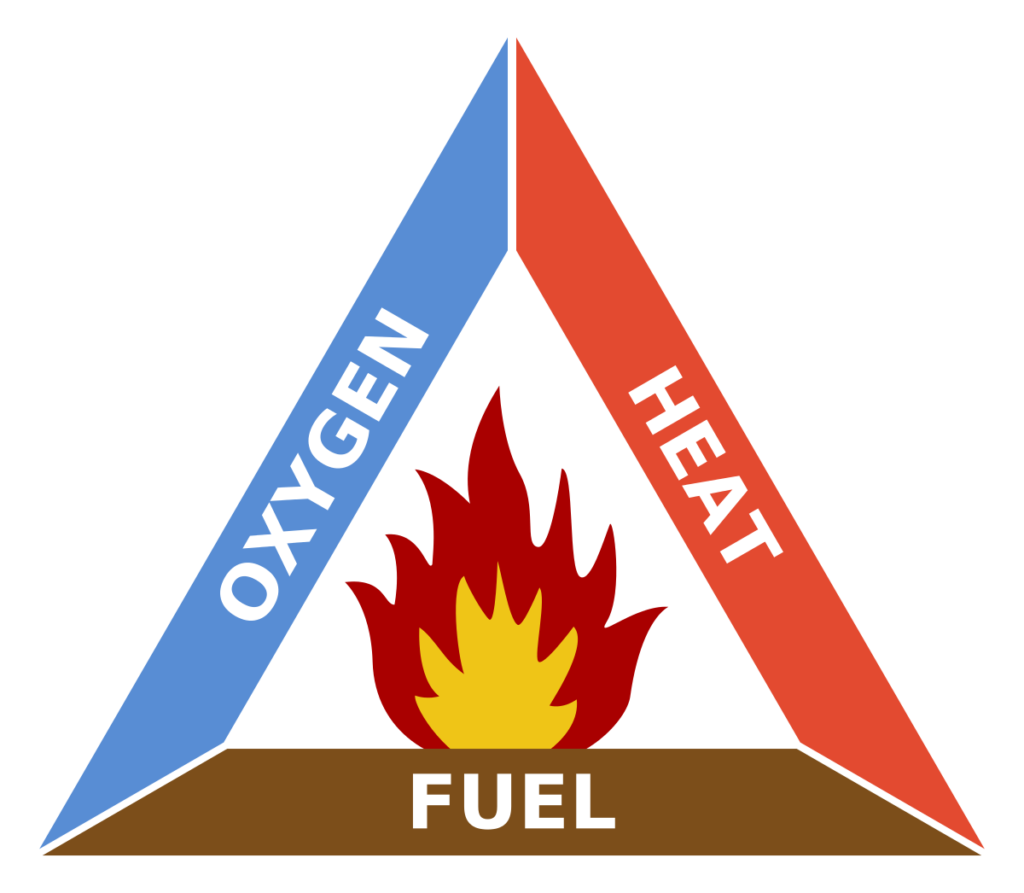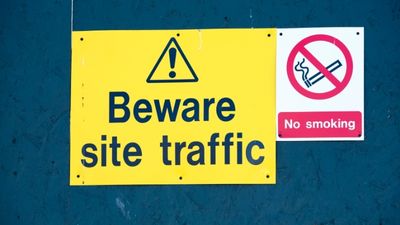Fire Safety in Construction

Estimated reading time: 7 minutes
Fire Safety in Construction
It is not uncommon for fires to start on construction and demolition sites or buildings that are being refurbished, the Home Office’s statistics revealed that there were 365 construction site fires in England between 2018/19 despite strict legal requirements and regulations for fire safety being in place. Fire safety in construction is an important topic to understand, especially if you are a site manager or working in this environment.

In this blog we discover why construction sites are prone fire incidents and explain the different hazards, with reference to the Fire Triangle, and offer suggestions as to how to prevent or minimise fires igniting and spreading in relation to these hazards. We also provide useful references to other resources such as fire legislation and Health and Safety Executive (HSE) guidelines*.
This is a two part blog, and in part two we look at the fire safety and emergency procedures that must be formulated at the design stage of the construction project, the role of the appointed ‘responsible person’ for fire safety and prevention and what makes an effective fire risk assessment.
Why is fire safety in construction a concern?
Fires on building sites are often an accident waiting to happen. But why is this the case? An explanation can be illustrated by the Fire Triangle. It explains how fires are initiated and sustained and provides a useful scientific principle to understand how to minimise fire risk.

The Fire Triangle illustrates that you need three elements – oxygen, fuel and heat to start and fuel a fire but by removing one of the elements then you can prevent or stop a fire.
While oxygen is hard to restrict, there is often several heat/ignition and fuel sources on a construction site, such as the use of hot welding tools and the availability of flammable liquids and materials.
These sources can often be found in close proximity, leading to fires starting and spreading. By understanding these different sources you can put strict controls in place to remove or reduce them, significantly reducing the risk of fire.
In addition, working conditions on a construction site are not static, making it much harder to implement rigorous fire safety measures and evacuation plans.
In this blog we review the two most common hazards that cause fires; fuel and ignition/heat sources and outline the proactive measures you can implement to control the risk.
Primary heat/ignition sources

Many activities on a construction site involve the generation of heat, the table below shows the most common heat sources which can ignite a fire and the preventative measures a site manager can implement to minimise risk.
| Heat Source | Fire Prevention Measure |
| Lighting, eg light fittings and bulbs | Check light bulbs regularly and make sure the correct wattage is used. Remove exposed or broken filaments immediately. |
| Heaters, eg portable electrical, gas and oil-fired heaters | Make sure heaters are not in constant use as they could overheat. Keep combustible materials away from heaters. All heaters should be correctly installed and comply with any regulations. Make sure all heaters are adequately ventilated. |
| Smoking, eg cigarettes, matches and lighters | If smoking is permitted put strict guidelines in place such as: Create designated smoking areas and make sure these are adhered to. Install suitable fire extinguishers near smoking areas. Provide metal bins and bins with metal covers for waste smoking materials. |
| Hot working, eg work activities that create heat, sparks or flames such as welding, grinding and cutting equipment | All workers using hot working equipment should wear the appropriate PPE. Provide correct and accessible fire extinguishers. All flammable products should be kept away from these working areas. |
| Electrical faults, eg electrical tools, old wiring, installing new electrical supplies | All electrical equipment should comply with regulations and inspected regularly. |
| Heavy plant, eg cranes and excavators | All vehicles should be fitted with fire extinguishers. Remove ignition keys when not in use. Ensure vehicles are not near the construction site or flammable materials. Fuel for the vehicles should be safely stored. Any leaking vehicle fuel from machine or vehicles should be removed immediately. |
| Arson/Vandalism | Lock and secure all entry points during down-time. Implement enhanced security features, eg motion detectors, security cameras and 24/7 security surveillance. |
| Temporary accommodation, eg prefabricated huts | Only allow authorised heaters, cooking facilities, and smoking in designated areas within these temporary structures. Make sure combustible materials are kept well away from these types of buildings. Install smoke detectors and adequate ventilation within these temporary structures. These structures should be made of fire-retardant materials and inspected regularly. |
Primary fuel sources
If ignitable substances are left too close to fuel sources then this is a major fire risk. Being aware of these potential fuel sources can dramatically reduce the risk of fire. The table below outlines the most common fuel sources found on a construction site and accompanying control measures you can implement to reduce fire risk.
| Fuel Source | Control Measures |
| Flammable products, eg generator fuel, liquid gas, oils, paints etc. | Design designated storage areas which have good ventilation. Only let authorised and trained staff use these materials. Ensure containers are tightly sealed and clearly labelled and there are measures in place for spillages. Limit quantities of these materials held on site and used at any one time. |
| Combustible construction materials, eg timber panels, wooden scaffolding boards and covering materials | Ensure these materials are fire retardant/resistant and they are kept away from flammable items. |
| Waste products | A waste management plan should be put in place for site waste, containing disposal information. Dispose of rubbish immediately if there is a build- up. Use metal bins to remove waste. |
Conclusion
We have discussed why fire safety in construction is important, looked in more detail about the number of ignition and fuel sources which can combine easily to perpetuate a fire and then considered the control methods that can be implemented to minimise and prevent fires breaking out.
In the second part of this blog, we review the fire safety and emergency procedures that must be contained in the initial design plan such as emergency plans, fire warning system and the implementation of fire detection and alarm systems. We also look at the role of the appointed ‘responsible person’ for fire safety and prevention on a construction site and the steps they need to take put together an effective fire risk assessment.
Additional resources*
- Regulatory Reform (Fire Safety) Order 2005 (FSO) in England and Wales and the Fire (Scotland) Act 2005 (FSA)
- The Construction (Design and Management) Regulations 2015 (HSE) and
- L153 – Managing health and safety in construction (CDM 2015)
- The Dangerous Substances and Explosive Atmospheres Regulations 2002 (DSEAR) (HSE)
- Fire safety in construction (HSE) – HSG168 Fire Safety in Construction – Guidance for Clients, Designers and Those Managing and Carrying Out Construction Work Involving Significant Fire Risks
- Fire Prevention on Construction Sites – Joint Code of Practice 10th Edition Released
Fire safety in construction training
For the site manager of a construction site, as well as abiding by the relevant fire regulations, such as appointing a ‘responsible person’, it is also important to ensure that all relevant staff have adequate fire safety training.
We offer online and face to face fire training courses, which are IFE approved and CPD accredited, which help you identify fire risks on your site and also cover topics such as fire extinguishers and fire safety signage. You can find out more information here:
Face-to-Face Fire Training Courses – Find a course in your area with our regional interactive map.
Online Fire Training Courses – Review our portfolio of online fire safety courses.
Our friendly customer support team is always happy to talk through your fire safety training options. Why not give us a call on 01327 552160, email us at hello@smarthorizons.co.uk, or use the live chat feature on this website to speak to us during office hours.
